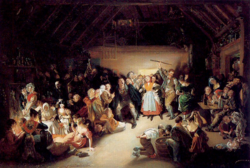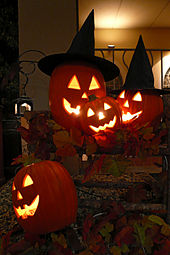HALLOWEEN
Halloween (or Hallowe'en) is an annual holiday observed on October 31, which commonly includes activities such as trick-or-treating, attending costume parties, carving jack-o'-lanterns, bonfires, apple bobbing, visiting haunted attractions, playing pranks, telling scary stories, and watching horror films.
Histori
Historian Nicholas Rogers, exploring the origins of Halloween, notes that while "some folklorists have detected its origins in the Roman feast of Pomona, the goddess of fruits and seeds, or in the festival of the dead called Parentalia, it is more typically linked to the Celtic festival of Samhain, whose original spelling was Samuin (pronounced sow-an or sow-in)".The name is derived from Old Irish and means roughly "summer's end".
Snap-Apple Night (1832) by Daniel Maclise.
Depicts apple bobbing and divination games at a Halloween party in Blarney, Ireland.
Depicts apple bobbing and divination games at a Halloween party in Blarney, Ireland.
The name 'Halloween' and many of its present-day traditions derive from the Old English era
Symbols
Development of artifacts and symbols associated with Halloween formed over time. For instance, the carving of jack-o'-lanterns springs from the souling custom of carving turnips into lanterns as a way of remembering the souls held in purgatory.The carving of pumpkins is associated with Halloween in North America where pumpkins are both readily available and much larger – making them easier to carve than turnips. The American tradition of carving pumpkins preceded the Great Famine period of Irish immigration and was originally associated with harvest time in general, not becoming specifically associated with Halloween until the mid-to-late 19th century.
The imagery of Halloween is derived from many sources, including national customs, works of Gothic and horror literature (such as the novels Frankenstein and Dracula), and classic horror films (such as Frankenstein and The Mummy). Among the earliest works on the subject of Halloween is from Scottish poet John Mayne in 1780, who made note of pranks at Halloween; "What fearfu' pranks ensue!", as well as the supernatural associated with the night, "Bogies"Robert Burns' (ghosts), influencing Halloween 1785. Elements of the autumn season, such as pumpkins, corn husks, and scarecrows, are also prevalent. Homes are often decorated with these types of symbols around Halloween.
Halloween imagery includes themes of death, evil, the occult, or mythical monsters. Black and orange are the traditional Halloween colors.
Costumes
Halloween costumes are traditionally modeled after supernatural figures such as monsters, ghosts, skeletons, witches, and devils. Over time, the costume selection extended to include popular characters from fiction, celebrities, and generic archetypes such as ninjas and princesses.
Dressing up in costumes and going "guising" was prevalent in Scotland and Ireland at Halloween by the 19th century. Costuming became popular for Halloween parties in the US in the early 20th century, as often for adults as for children. The first mass-produced Halloween costumes appeared in stores in the 1930s when trick-or-treating was becoming popular in the United States.
Halloween costume parties generally fall on, or around, 31 October, often falling on the Friday or Saturday prior to Halloween.
"TRICK OR TREAT...!!!"


ooow.,.,.,.,i'm afraid.,., !!!!!!!!
BalasHapusmandak yo kwe ra nglakoni ae lo..
BalasHapus